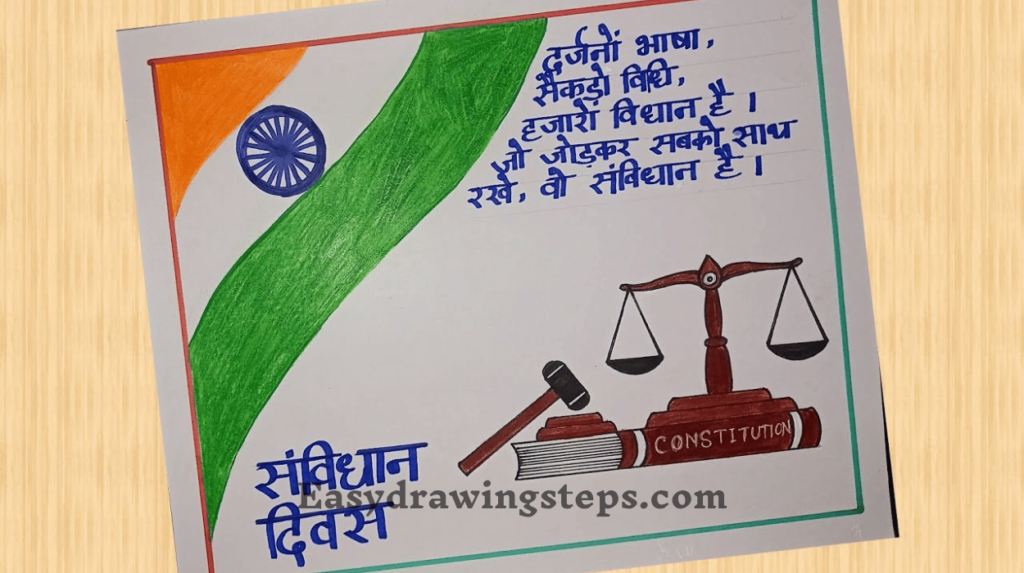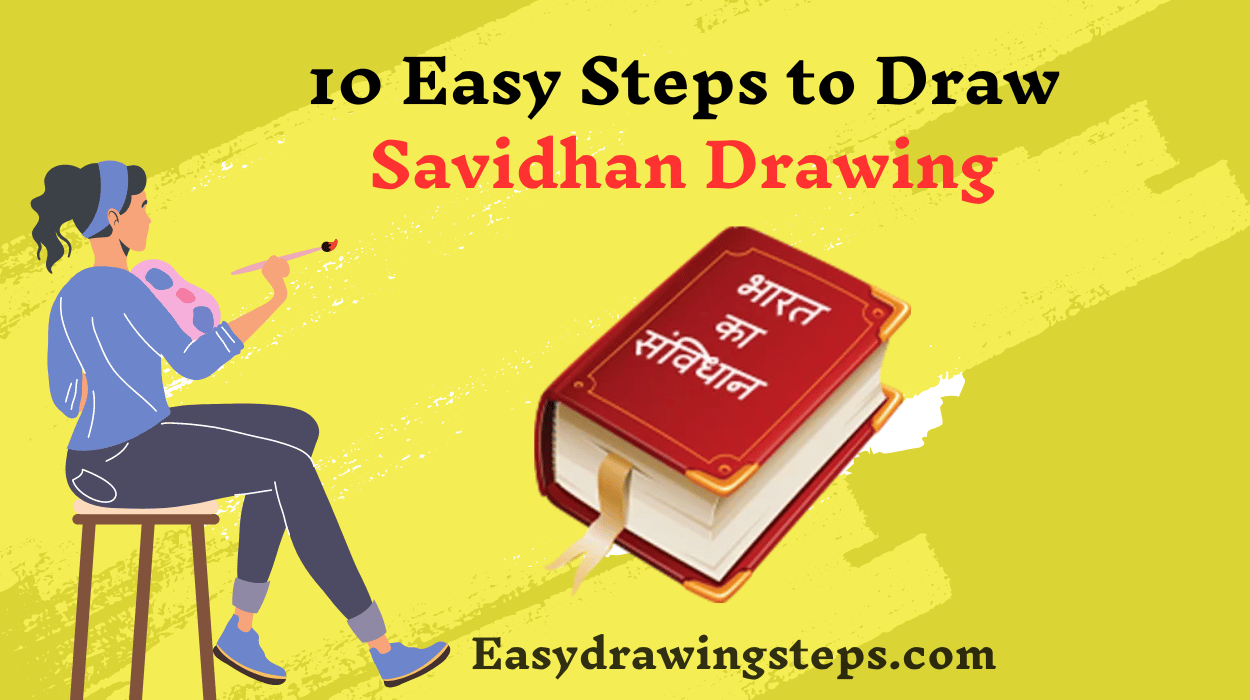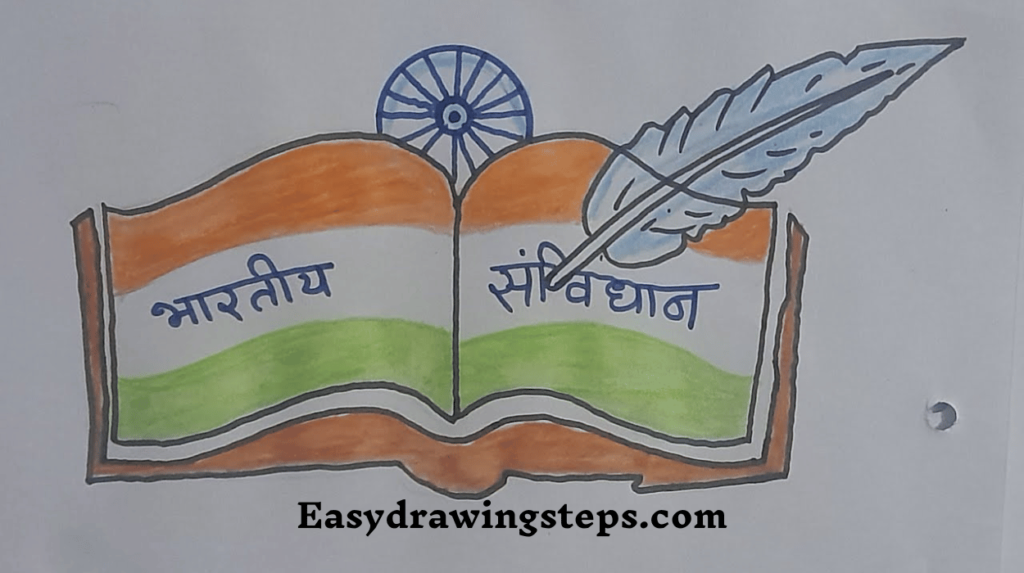Savidhan Drawing : Drawing the Indian Constitution or “Savidhan” is a great way to visually represent the essence of democracy, justice, and unity.
This artistic effort can include symbols, texts, and elements that symbolize the values of the Indian Constitution. Here’s a step-by-step guide to help you create a beautiful Savidhan drawing that reflects the spirit of India.
Step 1: Gather Your Materials
Before starting, gather essential materials:
- Drawing paper or canvas
- Pencils (for outlining and shading)
- Eraser
- Ruler
- Colored pencils, markers, or watercolors for adding color

Step 2: Start with the Constitution Book
Begin by drawing a simple book shape to symbolize the Indian Constitution. Draw a rectangle for the book cover, leaving space for the title and decorative borders. This rectangle should take up the central space on your paper, as it’s the focal point of the drawing.
Also Read : 10 Easy Steps to Draw Headphone Drawing
Step 3: Add the Title
At the top of the book cover, write “Bharat Savidhan” (भारतीय संविधान) in Hindi or English, depending on your preference. Make sure the letters are bold and neat, symbolizing the significance of the document.
Step 4: Draw the Ashoka Pillar Emblem
Below the title, draw the Ashoka Pillar, which is the national emblem of India. This consists of four lions standing back to back on a circular base. Pay attention to details like the lion’s mane, as it represents strength and pride. This emblem is usually positioned centrally on official constitutional documents.

Step 5: Create Borders and Patterns
The Indian Constitution is often seen with detailed borders on its cover. Add intricate patterns around the edges of the book to symbolize traditional Indian art. You can draw floral designs, geometric patterns, or other traditional motifs.
Step 6: Add the Scale of Justice
Since the Constitution represents justice, liberty, and equality, draw a symbol of justice, such as the weighing scales, on one side of the book. This adds a deeper meaning to your drawing, highlighting the values enshrined in the Constitution.
Also Read : 10 Easy Steps to Draw Lady Face Drawing
Step 7: Incorporate the National Flag
Draw the Indian tricolor flag near the book to symbolize national pride. Make sure the flag’s saffron, white, and green stripes are clear and distinct. The Ashoka Chakra in the center of the flag should have 24 spokes, representing eternal progress.
Step 8: Add Key Constitutional Words
To emphasize the core principles of the Constitution, write words like “Justice,” “Equality,” “Liberty,” and “Fraternity” around the book or in a banner near the drawing. These words reflect the Preamble of the Indian Constitution and its guiding philosophy.
Also Read : 10 Steps to Draw Gojo Satoru Drawing
Step 9: Use Color to Bring the Drawing to Life
Now, it’s time to add color. Use deep blue for the book cover to resemble the Constitution of India. Color the Ashoka Pillar in shades of gold and brown. The national flag should feature vibrant shades of saffron, white, and green. Ensure the colors are rich and highlight the important elements of your drawing.
Step 10: Final Touches
Once you’ve added color, use your pencil to outline the details more clearly. Darken the borders, add shadows where necessary, and ensure the writing is legible. Add finishing touches to make the overall drawing look polished and neat.
- Bharat Savidhan Drawing: Focus on the symbolism of the Indian Constitution, featuring the Ashoka Pillar and important national symbols.
- Bhartache Savidhan Drawing: You can emphasize the essence of Maharashtra’s cultural heritage while representing the Indian Constitution.
- Bhartiy Savidhan Drawing: Create a drawing that visually represents the Indian Constitution’s principles of justice, liberty, and equality.
- Bhartiya Savidhan Drawing: Focus on using Hindi script for the title and slogans, drawing the Constitution as seen in official documents.
By following these steps, your Savidhan drawing will not only be easy to create but will also reflect the profound message of India’s Constitution. Whether it’s for a competition or a project, this drawing will beautifully depict the values that bind the nation together.
Savidhan Drawing FAQ
What is the central focus of a Savidhan drawing?
The central focus of a Savidhan drawing is the depiction of the Indian Constitution. This can include elements like the Constitution book, the Ashoka Pillar, the national flag, and key constitutional values like justice, equality, and liberty.
Why is the Ashoka Pillar important in a Savidhan drawing?
The Ashoka Pillar, the national emblem of India, is important because it symbolizes strength, unity, and the ideals of the Constitution. It is often placed on official documents, including the Indian Constitution, making it a key part of any Savidhan drawing.
How can you represent the values of the Constitution in a Savidhan drawing?
You can represent the values of the Constitution by including symbols like the weighing scale for justice, the Indian tricolor for national pride, and words from the Preamble like “Liberty,” “Equality,” and “Fraternity.” These elements reflect the guiding principles of the Constitution.
What colors should be used in a Savidhan drawing?
In a Savidhan drawing, use deep blue for the Constitution book to represent its official appearance. The Ashoka Pillar should be colored in shades of gold or brown. The Indian flag should feature the correct colors: saffron, white, and green, with a navy blue Ashoka Chakra.
Can a Savidhan drawing include cultural elements?
Yes, a Savidhan drawing can include cultural elements like traditional Indian patterns, floral borders, and motifs that represent India’s heritage. These add richness to the drawing while still keeping the focus on the Constitution and its importance.



2 thoughts on “10 Easy Steps to Draw Savidhan Drawing”